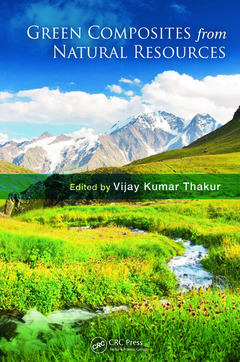Green Composites from Natural Resources
Coordonnateur : Thakur Vijay Kumar

Global awareness of environmental issues has resulted in the emergence of economically and environmentally friendly bio-based materials free from the traditional side effects of synthetics. This book delivers an overview of the advancements made in the development of natural biorenewable resources-based materials, including processing methods and potential applications in green composites. Biorenewable polymers are a special class of natural material found in nature, such as natural fibers, wheat straw, rice husk, and saw dust. In addition to offering renewable feedstocks, natural biorenewable materials are compostable, recyclable, edible, and more energy efficient to process than plastic.
Green Composites from Natural Resources covers various kinds of cellulosic biofibers, such as:
- hemp fibers
- jute
- saccaharum cilliare fibers
- pine needles
- grewia optiva fibers
- sisal fibers
- eulaliopsis binata
- flax fibers
- coconut fibers
- eulaliopsis binata
- baggase fibers
- rice husk
- saw dust
- wood flour
- straw
With scopes for the utilization of natural resources-based materials as potential replacements for traditional petroleum feedstocks on the rise, more scientists and researchers are exploring new composite materials based on biorenewable resources. This book provides information on more eco-friendly and sustainable alternatives to synthetic polymers and discusses the present state and growing utility of green materials from natural resources.
Green Composites: An Introduction. Valorization of Agricultural By-Products in Poly (Lactic Acid) to Develop Biocomposites. Processing Cellulose for Cellulose Fiber and Matrix Composites. Hemp and Hemp-Based Composites. Plant Fiber–Based Composites. Eulaliopsis Binata: Utilization of Waste Biomass in Green Composites. Bast Fibers Composites for Engineering Structural Applications: Myth or the Future Trend. Life Cycle Assessment for Natural Fiber Composites. Effect of Halloysite Nanotubes on Water Absorption, Thermal, and Mechanical Properties of Cellulose Fiber–Reinforced Vinyl Ester Composites. Eco-Friendly Fiber-Reinforced Natural Rubber Green Composites: A Perspective to the Future. Weathering Study of Biofiber-Based Green Composites. Machining Behavior of Green Composites: A Comparison with Conventional Composites. Potential Biomedical Applications of Renewable Nanocellulose. Green Composites from Functionalized Renewable Cellulosic Fibers. Properties and Characterization of Natural Fiber–Reinforced Polymeric Composites. Vegetable Oils for Green Composites. Index.
Vijay Kumar Thakur received his B.Sc, B.Ed, and M.Sc from Himachal Pradesh University, Shimla, India and his Ph.D from National Institute of Technology, Hamirpur, India. He worked for Lunghwa University of Science and Technology, Taiwan and Nanyang Technological University, Singapore before joining Washington State University, Pullman, USA as staff scientist. Member of the World Academic Publishing Conference Series: Engineering and Technology Frontier steering committee and the editorial board of several international journals on natural/synthetic polymers, composites, energy storage materials, and nanomaterials, he has coauthored five books, 20 book chapters, and one US patent, and published more than 100 research papers.
Date de parution : 11-2013
15.6x23.4 cm
Date de parution : 04-2017
15.6x23.4 cm
Thèmes de Green Composites from Natural Resources :
Mots-clés :
Natural Bers; Green Composites; Biomedical Applications; Natural Ber Composites; Structural Applications; Ber Composites; Nanocomposites; Green Polymer Composites; Natural Rubber; Cellulose Bers; Vegetable Oils; Thakur 2009a; Cellulose; Hemp Bers; Biopolymer and Green Composites; Plant Bers; Natural Resources; Chemical Resistance Behavior; Bast Bers; Lignocellulosic Bers; Exural Strength; Singha 2010b; Ber Volume Fraction; Ber Loading; Ber Matrix Adhesion; Sisal Ber; Ber Matrix Interface; Cellulose Nanowhiskers; HNTs; WH2; HNT Composite; Cutting Speed; Conventional Polymer Composites



